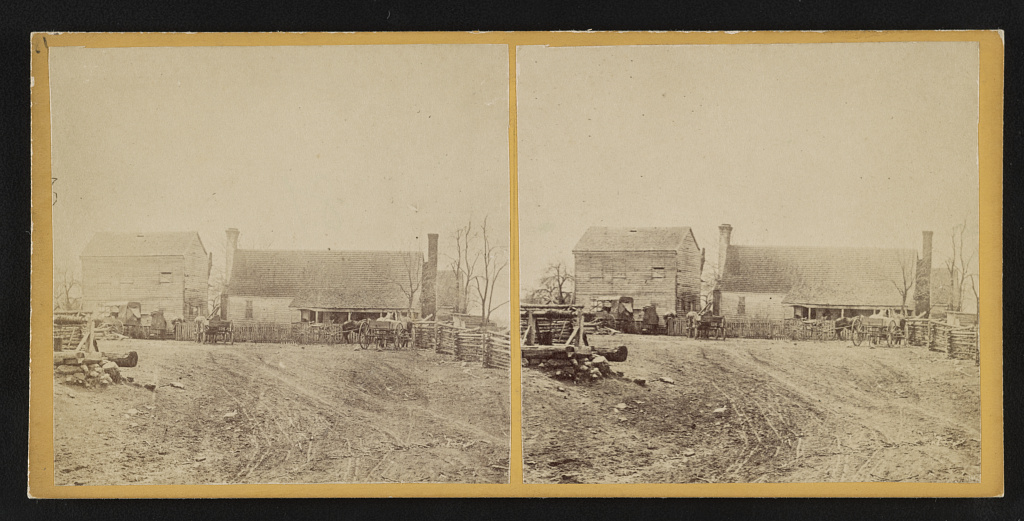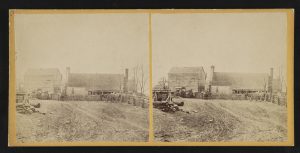DHR Announces 2021 Virginia Battlefield Preservation Grants to Protect 441 Acres


–General Assembly allotted $1 million for battlefield preservation in 2021–
–Targeted tracts are in the counties of Augusta, Henrico, Shenandoah, and Spotsylvania–
RICHMOND – The Department of Historic Resources has awarded grants from this year’s Virginia Battlefield Preservation Fund that will protect more than 441 acres associated with Civil War battlefields, including tracts affiliated with the actions of United States Colored Troops. The acreage targeted for preservation is located in Augusta, Henrico, Shenandoah, and Spotsylvania counties.
Based on the Department of Historic Resources' recommendations, the Commonwealth will award Virginia Battlefield Preservation Fund (VBPF) grants to two organizations, the American Battlefield Trust and the Shenandoah Valley Battlefields Foundation. These two nonprofits will use the VBPF grants to leverage private matching donations to preserve land tracts associated with four Civil War battlefields—Fisher’s Hill (Shenandoah Co.), Piedmont (Augusta Co.), Second Deep Bottom (Henrico Co.), and Spotsylvania Court House (Spotsylvania Co.).
The General Assembly established the VBPF in 2010, and authorized DHR to administer the fund by evaluating and disbursing grant awards to eligible recipients. After receiving more grant applications than the 2021 fund of $1 million can support, DHR determined this year’s selection, as it has in the past, through a rigorous evaluation process.
In accordance with VBPF stipulations, organizations that receive battlefield grants must donate an easement to the Virginia Board of Historic Resources on any acreage acquired with the state grants. The easements restrict or forbid development of the acreage, allowing for perpetual protection of the land.
In selecting the awards, DHR considered each battlefield's significance and ranking in Congress’s mandated “Report on the Nation's Civil War Battlefields,” issued in 1993 and subsequently updated. Additionally, DHR weighed factors in the grant applications such as the proximity of a battlefield parcel to already protected lands; the threat of encroaching development that could transform a parcel’s historic look and feel at the time of a battle; and the potential for education, recreation, research, or heritage tourism in connection with a battlefield tract.
Using these criteria, DHR will disburse to the—
- American Battlefield Trust three grants with combined totals of $565,000 to purchase 188.6 acres affiliated with two battles, as follows:
- $500,000 toward the purchase of 136.6 acres in Spotsylvania County connected to the Battle of Spotsylvania Court House;
- $49,500 toward the purchase of 49.7 acres, and $15,500 toward the purchase of 2.3 acres, all in Henrico County and associated with the Battle of Second Deep Bottom (among other battles).
- Shenandoah Valley Battlefields Foundation two grants totaling $435,000 to purchase easements on 252 acres associated with two battles:
- $235,000 toward a preservation easement on 106 acres in Shenandoah County associated with the Battle of Fisher’s Hill;
- $200,000 toward an easement on 146 acres in Augusta County tied to the Piedmont Battlefield, which is located along the Middle River.
“The preservation of historic battlefield properties contributes to Virginia’s significant and growing heritage tourism. Moreover, preserving these lands also supports low-impact recreational areas near to expanding urban centers, while in many cases also preserving targeted lands for agricultural uses under private ownership,” said Julie V. Langan, DHR director.
Battlefield Grant Awards 2021
Summaries of Battles & Association with Targeted Properties
(chronological order)
Fisher’s Hill Battlefield, Shenandoah Co.
Preserved Property: Foster Tract (106 acres)
Sponsor: Shenandoah Valley Battlefields Foundation (SVBF)
Confederate fortifications across the width of the valley at Fishers Hill prevented the Union army’s use of the Valley Turnpike (roughly U.S. 11 today). A Union attack on September 21, 1864 at Fisher’s Hill and a surprise Union flanking maneuver on September 22 resulted in a Confederate retreat, opening the Shenandoah Valley to Union Gen. Phil Sheridan’s destruction of mills, barns, crops and livestock later that year. The purchase of an easement on the Foster Tract by SVBF will protect a property that is entirely within the core and study area of the Fisher’s Hill Battlefield. Part of the Foster Tract was used as a Confederate defensive position multiple times throughout the Civil War. During the Battle of Fisher’s Hill, Confederate cavalry under Gen. Lunsford Lomax were entrenched on the property before the Confederate left flank was turned and the defenses were overrun from Union infantry and cavalry that swept across the Foster Tract. The property will remain in private ownership with a preservation easement placed on it. Civil War–era features on the property consist of an 1839 brick farmhouse, which served as a battlefield landmark, two stone outbuildings, a summer kitchen that has been converted to a residence, and a carriage house that has been converted to a garage. There is also a log double-pen bank barn from the same period that has been covered with metal siding.
Spotsylvania Court House Battlefield, Spotsylvania Co.
Preserved Property: Todd’s Tavern Tract (136.6 acres)
Sponsor: American Battlefield Trust
The Battle of Spotsylvania Court House, also known as the Battle of Spotsylvania, was the second major battle in Lt. Gen. Ulysses S. Grant’s 1864 Overland Campaign. It followed the bloody but inconclusive Battle of the Wilderness, after Grant's army disengaged from Confederate Gen. Robert E. Lee’s army and moved to the southeast, where Grant attempted to lure Lee into battle under more favorable conditions. Elements of Lee's army outpaced the Union army to the critical crossroads of Spotsylvania Court House, where Lee’s forces began entrenching. Fighting occurred on and off from May 8 through May 21, 1864, as Grant tried various schemes to break the Confederate line. In the end, the battle was tactically inconclusive, although both sides declared victory. The Confederacy deemed it a victory because its forces held their defenses. The Union did so because its offensive continued and Lee's army suffered irreplaceable losses. With almost 32,000 casualties on both sides, Spotsylvania was the costliest battle of the campaign. Todd’s Tavern, a pivotal landmark during the Battles of the Wilderness and Spotsylvania Court House, once stood on the southern portion of today’s Todd’s Tavern Tract. Constructed in 1835, Todd’s Tavern, a one-and-a-half story structure, was operated during the Civil War by Charles Bradshaw, who was assisted by an enslaved person and a free African American. On the night of May 7, 1864, Generals Grant and George Meade rode south along the Brock Road, skirting the Todd’s Tavern Tract and stopping briefly at Todd’s Tavern. The Union Second and Fifth Corps marched past the Todd’s Tavern Tract toward Spotsylvania Court House, and the Second Corps camped on the property from May 8-9. Confederate General Thomas Rosser’s cavalry brigade spent the night of May 14 at Todd’s Tavern. The next day Rosser marched east on the Catharpin Road and engaged the 2nd Ohio Cavalry and 23rd United States Colored Troops in a skirmish southeast of Chancellorsville.
Battle of Piedmont, Augusta Co.
Preserved Property: Shiflett Tract (146.6 acres)
Sponsor: Shenandoah Valley Battlefields Foundation (SVBF)
In the spring of 1864, new Union commander Gen. Ulysses S. Grant organized a huge offensive across the entire front of the embattled Confederacy, including in the Shenandoah Valley. After a disastrous defeat for Union forces under Gen. Franz Sigel at the Battle of New Market (May 15, 1864), Sigel was replaced by the aggressive Gen. David Hunter. By early June, the Federals were on the move again, bearing down on their objective—the vital Confederate rail and supply center of Staunton. Confederate Gen. William E. “Grumble” Jones hurriedly gathered a force to block Hunter’s advance. Eventually, Jones deployed the main part of his forces in an L-shape, anchored on a bend of Middle River facing north and angling south along a ridge line, along the Shiflett Tract. The other part, Confederate reserves consisting of home guards, was in the woods south and east of the hamlet of Piedmont. The Battle of Piedmont occurred on June 5, 1864, and ended in a Union victory after Hunter’s forces routed the Confederates, who suffered some 1600 casualties including the death of Jones. Most of the day’s fighting took place on the Shiflett Tract. As a result of the Union victory at Piedmont, Hunter’s army, which lost about 875 men during the battle, had its way clear to Staunton and Lexington. It marched into Staunton the next day, destroyed Confederate military stores, and then burned the Virginia Military Institute days later in Lexington.
Deep Bottom Battlefields, Henrico Co.
Preserved Property: Robertson-Welch Tracts (49.7 acres) and Jackson Tract (2.3 acres)
Sponsor: American Battlefield Trust
- First Deep Bottom: This July 27–29, 1864 battle was part of the Siege of Petersburg. During the night of July 26 and 27, the Union Army II Corps and two divisions of Gen. Phil Sheridan’s cavalry under the command of Maj. Gen. Winfield Hancock crossed to the north side of James River to threaten Richmond, diverting Confederate forces from the impending attack at Petersburg on July 30. Union forces abandoned efforts to turn the Confederate position at New Market Heights and Fussell's Mill after Confederates strongly reinforced their lines and counterattacked. During the night of July 29, the Federals re-crossed the river, leaving a garrison to hold the bridgehead at Deep Bottom.
- Second Deep Bottom--Fussell’s Mill: Fighting at Fussell’s Mill on August 14 and 16, 1864, diverted Confederate attention from Union attacks on the Petersburg Railroad.
The Robertson-Welch Tracts and the Jackson Tract are located in the core and study areas of the Second Deep Bottom, First Deep Bottom, Glendale, and Fair Oaks and Darbytown Road Battlefields. During Second Deep Bottom, on August 15, the 7th U.S.C.T. and 9th U.S.C.T. marched through the Welch Tract to assume a reserve position behind the main Union line, and the 9th Regiment Infantry U.S.C.T. was involved in skirmishes at Deep Bottom August 14-15 as well as with Darbytown Road on October 13 and the Battle of Fair Oaks on October 27-28. The U.S.C.T. 7th Regiment Infantry was also involved with Darbytown Road on October 13 and the Battle of Fair Oaks on October 27-28. Protecting these tracts will allow ABT to interpret the U.S.C.T. role in the battle. The Robertson-Welch Tracts are adjacent to land previously preserved by the Trust and the Richmond Battlefields Association.










